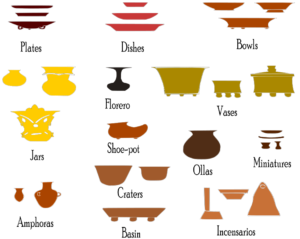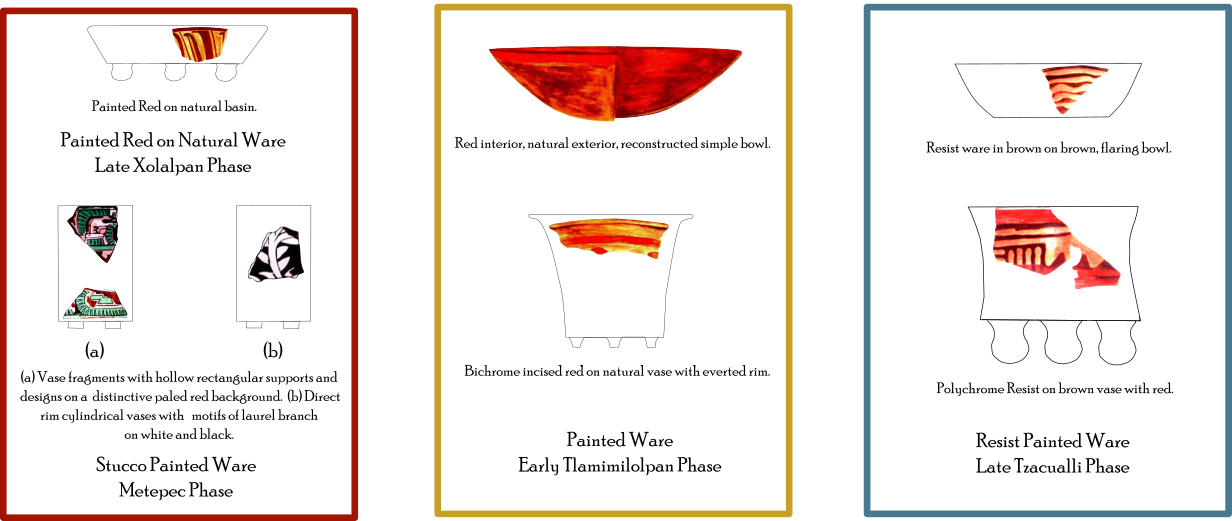Relative chronology
By observing the stratigraphic layers and their sequence at a site, we can establish what happened first and what happened next, assuming that: (a) the deepest layer is the oldest; (b) the layers were deposited sequentially; and (c) the site has not been altered. This is called relative chronology.
To establish a relative chronology, archaeologists employ methods relating with other objects or phenomena occurring in one place or geographical area, although we cannot get exact dates we can learn what objects or phenomena occurred before, after or if they were contemporaneous.
In archaeology, ceramic materials have been widely used to establish the relative chronology of a site, also known as ceramic chronology. This has been possible at Teotihuacan because of the large number preserved sherds reflecting gradual and consistent changes over time. These changes include transformations in form, style, raw material, and manufacturing technique, which allowed archaeologists to distinguish temporal trends in the archaeological record.
Teotihuacan ceramic chronology
The ancient inhabitants of Teotihuacan had a remarkably diverse and widespread pottery tradition. In the mid-nineteenth century during the first explorations in the Teotihuacan area, hundreds of sherds were visible on the surface. Even today, fragments of pottery scattered on the earth’s surface can be easily recognized by the trained eye. After more than a century’s worth of investigation in the area, we have extensive knowledge of Teotihuacan pottery thanks to the efforts and studies developed by early explorers such as Manuel Gamio, Eduardo Noguera, Pedro Armillas, Sigvald Linné, Alfred L. Kroeber, René Millon, George Cowgill, and Evelyn Rattray, to name a few.
Our methodology for ceramic analysis follows the typology proposed in Rattray’s 2001 publication which summarizes previous ceramic analyses in the area in addition to her own results from various stratigraphic test pits. Moreover, our project complies with some of the typological points proposed by Dr. George Cowgill (personal communication).
Rattray established her ceramic chronology based on published descriptions of Teotihuacan ceramics as well as recent ceramic analyses that linked these finds to known absolute dates. Taking into consideration archaeological context, Rattray presents a detailed definition of ceramic typology at Teotihuacan. Her chronology was based on thousands of pieces of pottery from multiple stratigraphic test pits recovered during the Teotihuacan Mapping Project from 1966 to 1969 (Millon, 1973). She also examined material from her own excavations carried out in 1972 at the Citadel as well as material recovered by Starbuck in Yayahuala in 1973, among other recorded contexts (Rattray, 2001).
How is a ceramic chronology constructed?

When ceramic materials are recovered from excavation pits, they are often just fragments of what originally constituted a pot, a vase, a figurine, or any other ceramic artifact. These isolated pieces are referred to as sherds. In the image to the right, you can see what sherds look like once they are cleaned.
According to their shapes and sizes, ceramics are classified based on these forms. In the following illustration, you can see the basic forms identified at Teotihuacan.
From studying and comparing different characteristics of ceramics (e.g., shape and size, style, surface finish, type of paste, colors), many researchers have classified the ceramics and established a typology for Teotihuacan. Below is an illustration of Rattray’s ceramic typology of Teotihuacan which is currently used to classify ceramic deposits. This typology diagram illustrates some examples of the different variants of ceramic across time.

The different ceramic typologies can be further classified into ceramic wares or groups which mainly focus upon the typology, surface finish, and paste type of each ceramic. To date, the following ceramic groups have been identified at Teotihuacan (local):
- Matte Ware (coarse matte and fine matte finishes on covers, cover plates, ornaments, and miniatures)
- Burnished Ware (ollas (or large jars) and comales)
- Polished Ware (bowls, plates, vases, and Tlaloc vessels)
- Painted Ware (monochrome and bichrome bowls, vases, and jars)
- Stuccoed and Painted Ware (various)
- Copa Ware (vases and copas)
- San Martin Orange Ware (large cooking and storage vessels, craters, and amphoras)
Also common are the foreign ceramic types Thin Orange Ware and Granular Ware. For more details, don’t forget to visit the section on Ceramic Analysis.

Records of changes in different types of ceramics used over time form the basis of a ceramic chronology. By documenting the stratigraphic location where the different ceramic types and wares were distributed and their frequency has helped tie the ceramic typology to specific occupation periods at Teotihuacan. Currently ceramic chronology is the most widely applied and most reliable technique to obtain a relative chronology.
There are many studies on ceramic chronology; we can check the typology and chronology ceramics established for Teotihuacan in Rattray’s book (2001). By looking at previous studies related to ceramics, Rattray did not have to create many new categories but expanded and improved existing classifications. For this reason, we know that people from ancient Teotihuacan manufactured different types of ceramics for different uses and purposes.

References
Millón, R. 1973. Urbanization at Teotihuacan, Mexico, Vol. 1, Part I: Text. Austin: University of Texas Press, pp. 154.
Millón, R., Drewitt, R., and Cowgill, G. 1973. Urbanization at Teotihuacan, México. Vol. 1, Part II: Maps. The Teotihuacán Maps. Austin: University of Texas Press, 147 map sheets + 3 folding maps.
Rattray, Evelyn Childs. 2000a. Teotihuacan: Ceramics, Chronology, and Cultural Trends. University of Pittsburgh Memoirs in Latin American Archaeology, No. 13.
Rattray, Evelyn Childs. 2000b. Teotihuacan: Ceramics, Chronology, and Cultural Trends — Color Illustrations. Latin American Archaeology Database, University of Pittsburgh. <URL: http://www.pitt.edu/~laad/rattray/>
Rattray, Evelyn Childs. 2001. Teotihuacan: Cerámica, Cronología, y Tendencias Culturales. Serie Arqueología de Mexico, Instituto Nacional de Antropología e Historia. Mexico, D. F., pp. 617 pp. + tablas de frecuencias de los grupos cerámicos.